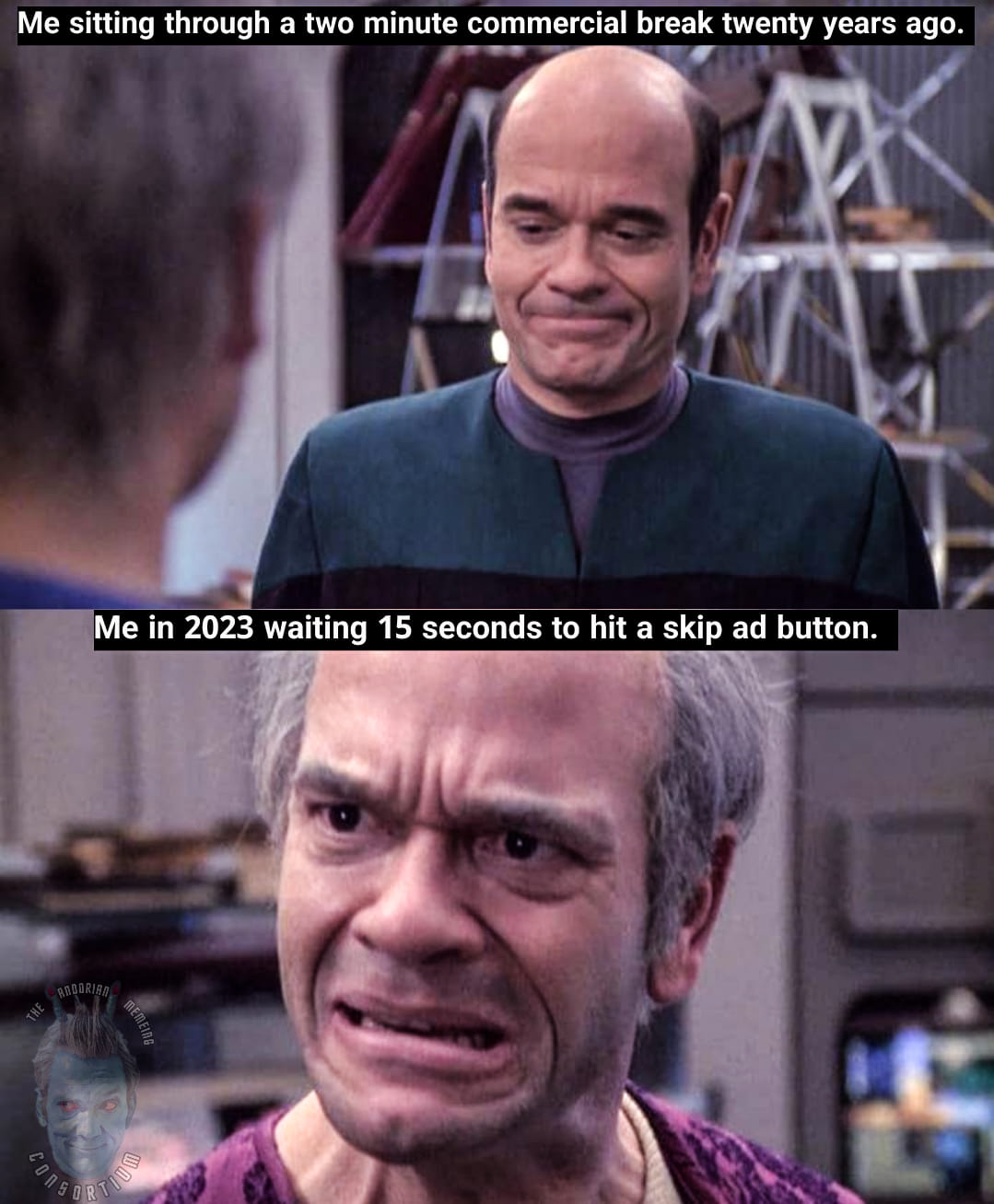Meme Categories:
Category: Anti-Advertising

First Seen:
2023-07-18T18:31:44+00:00
Gemma-3-27b's Take:
Okay, let's break down this meme through various critical lenses. ## Visual Description The meme is a two-panel comparative image. Both panels feature Patrick Stewart as Captain Jean-Luc Picard from *Star Trek: The Next Generation*. * **Top Panel:** Picard is seated, presumably in his Captain's chair on the *Enterprise*, looking serene and almost bemused. The lighting is dramatic, emphasizing his expression. The text above reads "Me sitting through a two minute commercial break twenty years ago." * **Bottom Panel:** A closer, heavily zoomed-in shot of Picard, now appearing visibly distressed—eyes squeezed shut, face contorted in frustration. The text reads "Me in 2023 waiting 15 seconds to hit a skip ad button." The stark contrast in Picard's expression and framing is the central comedic element. The meme visually embodies the frustration with the increasing prevalence and inaccessibility of ad-skipping in contemporary digital media. ## Foucauldian Genealogical Discourse Analysis Foucault's work can help us understand how the *experience* of advertising—and resistance to it—has shifted over time, constructing new subject positions. * **Power/Knowledge:** Twenty years ago, commercial breaks were a *given* – an accepted part of the media landscape. We passively accepted the power of advertisers to interrupt our programming. The discourse around advertising was largely *about* products and their desirability. Now, the shift is toward *control* – specifically, the desire to control *when* and *how* we are exposed to ads. This shift itself is a manifestation of power – the user attempting to reclaim agency over their viewing experience. * **Genealogy of Control:** The meme highlights a change in the *technology* of control. Previously, passive reception was the norm. Now, the (often thwarted) expectation of ad-skipping introduces a new level of engagement—and frustration. The genealogy (historical development) of this control can be traced from limited commercial breaks to streaming services with pre-roll and mid-roll ads, then to increasing delays on skip buttons, shaping our expectations and our annoyance. * **Disciplinary Power:** The meme subtly reveals how ad-skipping buttons are designed to exert a form of disciplinary power. The delay in being able to skip creates a moment of *forced* exposure, even if it’s just a few seconds. This acts as a micro-punishment, reinforcing the power of advertisers. ## Critical Theory The meme speaks to broader themes within Critical Theory relating to the *culture industry* and the commodification of attention. * **Commodification of Attention:** The meme highlights how advertising has moved beyond simply selling products to selling *our attention*. The extended ad formats and frustrating skip delays are not about maximizing sales as much as maximizing the time we spend exposed to advertisements. Our attention becomes a commodity in itself. * **False Consciousness:** The image suggests a form of awakening from "false consciousness." Twenty years ago, we were largely conditioned to accept advertising as a necessary evil. Now, we are increasingly aware of its manipulative potential and actively resist it, even in small ways like clicking on a skip button. * **The Erosion of Experience:** The meme can be seen as a critique of how advertising has fragmented and commodified our viewing experiences. The "seamless" flow of entertainment has been interrupted by constant intrusions, leading to a sense of frustration and alienation. ## Marxist Conflict Theory From a Marxist perspective, the meme reveals the inherent conflict between capital (advertisers) and the audience (consumers). * **Means of Production & Control:** Advertisers, as the owners of the “means of production” (the advertising industry), seek to maximize profit by controlling our attention. The meme illustrates a struggle over this control. The increasingly frustrating ad-skipping mechanisms are a tactic used by capital to maintain its dominance. * **Alienation:** The meme encapsulates a sense of alienation from the media experience. Previously, entertainment was seen as a source of leisure and enjoyment. Now, it's constantly interrupted by forces that seek to exploit our attention, creating a sense of disconnect. * **Class Struggle**: Though subtle, it hints at a micro-level class struggle: advertisers representing a powerful economic class seeking to exert control over the attention (and thus, consumption) of the masses. ## Postmodernism From a postmodern perspective, the meme deconstructs the idea of a "natural" viewing experience. * **Simulation & Hyperreality:** The constant bombardment of advertisements creates a hyperreal environment where it becomes increasingly difficult to distinguish between "authentic" content and commercial messaging. The meme acknowledges this fragmentation and loss of authenticity. * **Irony & Parody:** The use of Captain Picard, a figure associated with a utopian vision of the future, is inherently ironic. It highlights the contrast between the promise of technology and the reality of being constantly bombarded with advertisements. * **Deconstruction of Narrative:** Traditional narrative structures are disrupted by constant commercial breaks. The meme subtly acknowledges this disruption and the fragmentation of experience that results. **In conclusion:** The meme is deceptively simple, but it touches on a range of complex social and cultural issues. It highlights the changing relationship between viewers, advertisers, and the media, and it encapsulates a sense of frustration and resistance in the face of increasing commercialization.
Llama-3.2-11b's Take:
This meme is a humorous commentary on the passage of time and the changing nature of advertising. It features two images from the TV show Star Trek: The Next Generation, with the top image showing a character looking calm and relaxed, while the bottom image shows the same character looking angry and frustrated. The text at the top reads "Me sitting through a two-minute commercial break twenty years ago," and the text at the bottom reads "Me in 2023 waiting 15 seconds to hit a skip ad button."